The Commercial Electric Restaurant Ranges Market is estimated to be valued at USD 49.6 billion in 2025 and is projected to reach USD 85.6 billion by 2035, registering a compound annual growth rate (CAGR) of 5.6% over the forecast period.
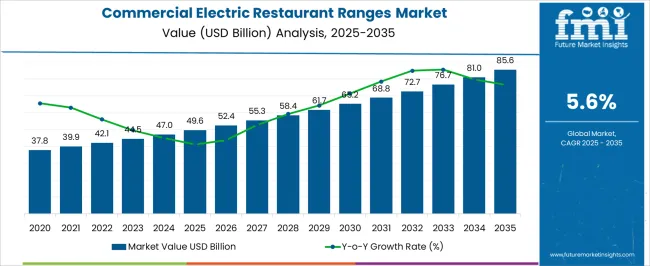
| Metric | Value |
|---|---|
| Commercial Electric Restaurant Ranges Market Estimated Value in (2025 E) | USD 49.6 billion |
| Commercial Electric Restaurant Ranges Market Forecast Value in (2035 F) | USD 85.6 billion |
| Forecast CAGR (2025 to 2035) | 5.6% |
The commercial electric restaurant ranges market is experiencing steady growth as foodservice operators transition toward energy efficient and environmentally sustainable kitchen equipment. Rising electricity based infrastructure in urban areas, combined with regulatory restrictions on gas based appliances in certain regions, has accelerated the adoption of electric ranges.
Advancements in heating elements, temperature control systems, and induction technologies are improving performance efficiency, enabling faster cooking and consistent results across high volume kitchens. Operators are increasingly seeking appliances that support lower operating costs, simplified maintenance, and compliance with evolving energy standards.
Additionally, the shift in consumer dining preferences toward quick service formats and delivery centric models is influencing equipment investment. The market outlook remains positive as restaurants continue to prioritize operational efficiency, sustainability, and cost effectiveness in their equipment decisions.
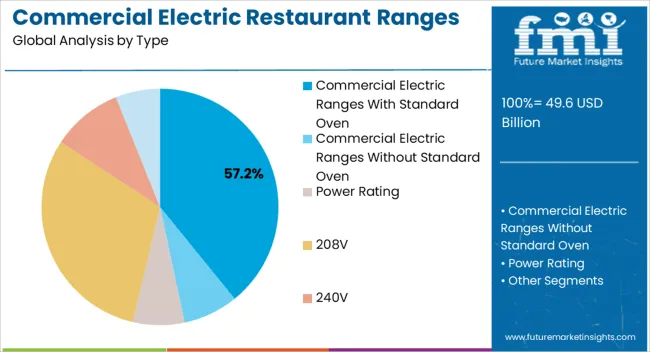
The commercial electric ranges with standard oven segment is expected to contribute 57.20% of total market revenue by 2025 within the type category, making it the leading segment. Its dominance is being driven by versatility, as it combines traditional range top functions with an integrated oven, allowing for a wide variety of cooking methods within a single unit.
Foodservice operators value this combination for its ability to optimize kitchen space while maintaining consistent output. The segment has further benefited from advancements in heating technology that ensure even temperature distribution and reduced energy consumption.
Its adaptability to different cuisines and operational models has solidified its position as the most widely adopted type in the market.
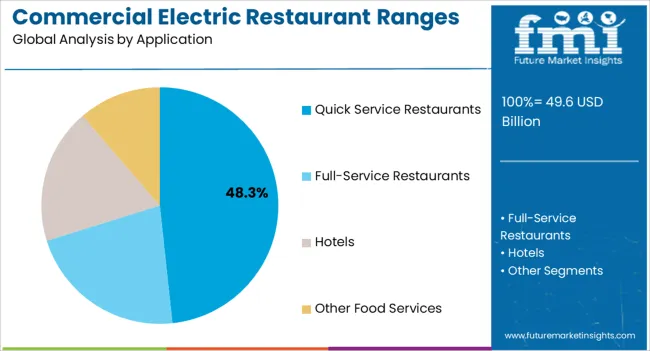
The quick service restaurants application segment is projected to account for 48.30% of the total market revenue by 2025, establishing it as the dominant application area. Growth is being fueled by the expansion of fast food and chain restaurants that demand high throughput equipment capable of supporting rapid menu preparation.
Quick service restaurants rely on electric ranges for their reliability, ease of cleaning, and compliance with energy efficiency standards. The increasing trend of delivery centric operations and high volume service models has also reinforced reliance on electric ranges to ensure consistency and speed.
With global quick service brands continuing to expand and standardize their kitchen operations, this application segment has emerged as the primary driver of demand in the commercial electric restaurant ranges market.
The global demand for Commercial Electric Restaurant Ranges is projected to increase at a CAGR of 5.6% during the forecast period between 2025 and 2035, reaching a total of USD 85.6 Billion in 2035, according to a report from Future Market Insights (FMI). From 2020 to 2025, the demand witnessed significant growth, registering a CAGR of 3.3%.
According to Future Market Insights, a market research and competitive intelligence provider, the Commercial Electric Restaurant Ranges market was valued at USD 49.6 Billion in 2025.
Commercial kitchens are increasingly looking for customizable cooking solutions that can meet the demands of a diverse range of cuisines and menus. Electric ranges offer a range of cooking surfaces and controls, which can be customized to meet the specific needs of a particular recipe or cooking style.
Additionally, the foodservice industry is growing, with increasing demand for food delivery and takeout services. Electric ranges offer quick and efficient cooking, making them an ideal option for restaurants and other foodservice businesses that need to meet tight delivery schedules.
Furthermore, many governments around the world are implementing initiatives to promote energy efficiency and reduce greenhouse gas emissions. This includes incentives for businesses to switch to more energy-efficient appliances, such as electric ranges, which are seen as a more environmentally friendly option than gas ranges. For instance, the United States Environmental Protection Agency's (EPA) ENERGY STAR program provides guidelines and certifications for energy-efficient appliances, including commercial electric ranges. The program encourages the use of energy-efficient appliances by providing businesses with incentives to switch to more energy-efficient models.
Increasing Demand for Energy-Efficient Equipment to Fuel the Market Growth
Energy efficiency is a key concern for restaurants and commercial kitchens, as energy costs can make up a significant portion of their overall operating expenses. Commercial electric restaurant ranges are highly energy-efficient and can help businesses reduce their energy consumption, which can lead to significant cost savings over time. Electric ranges are more energy-efficient than their gas counterparts because they convert almost all of the energy they consume into heat. In contrast, gas ranges lose a significant amount of energy through the exhaust, resulting in higher energy costs. Additionally, electric ranges heat up faster than gas ranges, which can save time and energy during cooking.
Moreover, energy-efficient commercial electric restaurant ranges are designed with features such as induction technology, which generates heat only when a pot or pan is placed on the burner. This reduces energy waste and saves electricity, as heat is not being produced unnecessarily. As businesses become more environmentally conscious and energy prices continue to rise, the demand for energy-efficient commercial electric restaurant ranges is expected to increase. This trend is likely to drive the growth of the commercial electric restaurant ranges market.
Technological Advancements to Accelerate the Market Growth
The foodservice industry is constantly evolving, and technological advancements are a major driver of this change. Commercial electric restaurant ranges are not immune to this trend and are becoming increasingly advanced and sophisticated in their design. Manufacturers are introducing new features in commercial electric restaurant ranges that improve their efficiency and productivity, which can lead to increased demand for these appliances. For example, some commercial electric restaurant ranges now feature touchscreens that allow users to easily control temperature settings, cooking time, and other important parameters. These touchscreens can also display recipe suggestions and cooking tips, making them a valuable tool for chefs and cooks.
Programmable settings are another technological advancement that can increase the efficiency of commercial electric restaurant ranges. These settings allow users to program specific cooking times and temperatures for different dishes, reducing the need for manual adjustments and potentially saving time during busy periods. In addition, advanced temperature control systems are becoming more common in commercial electric restaurant ranges. These systems can maintain precise temperatures throughout the cooking process, ensuring that food is cooked evenly and reducing the risk of overcooking or undercooking.
High Initial Cost of Commercial Electric Restaurant Ranges to Restrain the Market
Commercial electric restaurant ranges are generally more expensive than their gas counterparts. The higher cost is due to several factors, including the cost of the technology used to manufacture electric ranges and the higher electricity consumption. The higher initial cost can be a barrier for some businesses, particularly smaller ones with limited budgets, as they may not have the financial resources to make the investment.
In addition to the cost of the range itself, businesses may also need to invest in costly electrical upgrades to ensure that their electrical systems can support the higher electrical load required to operate electric ranges. This additional cost can further limit the appeal of electric ranges for some businesses, particularly those with limited budgets. Moreover, despite the long-term cost savings from energy efficiency, businesses may prioritize cost savings in the short-term, which could limit their willingness to invest in electric ranges.
Limited Versatility to Limit the Market Growth
Another factor that could limit the appeal of electric restaurant ranges is their limited versatility compared to gas ranges. Gas ranges are often preferred by chefs and cooks because they provide more precise temperature control and can quickly heat up and cool down, which is important for certain cooking techniques. Also, in comparison, electric ranges often have slower response times and may not provide the same level of temperature control as gas ranges. This can be a disadvantage for businesses that require a high level of precision and flexibility in their cooking equipment.
Moreover, electric ranges may not be suitable for certain cooking techniques, such as open flame cooking or wok cooking, which rely on the intense heat generated by gas flames. This can limit the appeal of electric ranges for businesses that specialize in these types of cuisine.
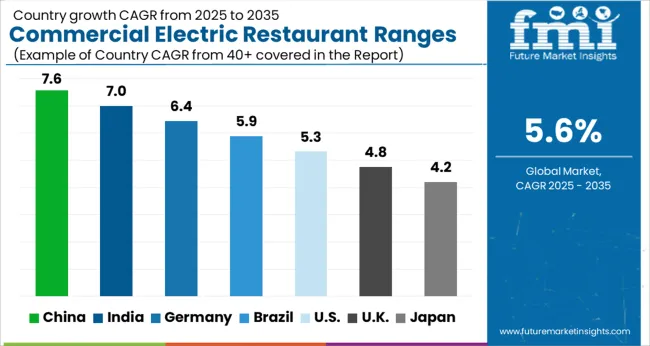
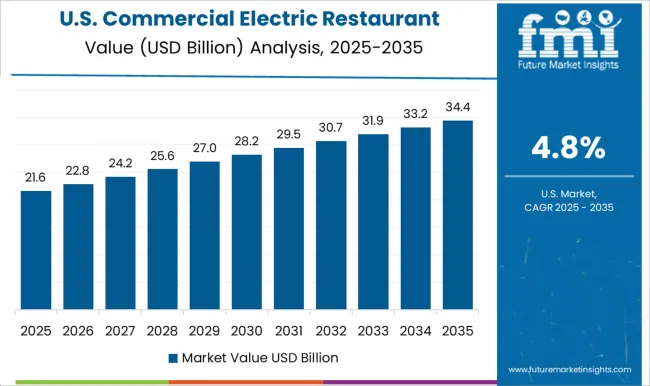
Integration of Advanced Technologies in North America to Fuel the Market Growth
The Commercial Electric Restaurant Ranges Market in the United States is expected to accumulate the highest market share of 33.4% in 2025.
With the growing concern for environmental sustainability and rising energy costs in the region, there is a shift towards using energy-efficient and eco-friendly kitchen equipment, including electric restaurant ranges. Moreover, the trend of using electric restaurant ranges is increasing due to their convenience, easy-to-use features, and lower maintenance requirements, making them an attractive option for commercial kitchens. Additionally, with the growth of the foodservice industry, there is an increasing demand for commercial kitchens, which is expected to drive the demand for commercial electric restaurant ranges in the region.
Furthermore, the integration of advanced technologies, such as sensors, automation, and digital displays, into electric restaurant ranges is expected to enhance their performance, efficiency, and accuracy, thereby driving the growth of the regional market. In addition, government initiatives and regulations promoting energy efficiency and eco-friendliness are expected to drive the demand for electric restaurant ranges in North America.
Rising Government Initiatives in the Region to Fuel the Market Growth
The Commercial Electric Restaurant Ranges Market in India is expected to accumulate the highest market share of 6.3% in 2025.
With the rising concerns over energy costs and environmental sustainability in the region, there is a growing demand for energy-efficient kitchen equipment, including electric restaurant ranges. The adoption of energy-efficient equipment in commercial kitchens can help reduce energy costs and minimize carbon footprint. Also, the foodservice industry in Asia Pacific is growing rapidly, driven by factors such as urbanization, changing consumer preferences, and increasing disposable incomes. This is expected to drive the demand for commercial kitchen equipment in the region, including electric restaurant ranges.
Additionally, the convenience, ease of use, and lower maintenance requirements of electric restaurant ranges are making them an attractive option for commercial kitchens in Asia Pacific. Additionally, the cost of electricity is often lower than that of gas in many parts of Asia Pacific, further driving the adoption of electric ranges. Moreover, several governments in Asia Pacific are promoting the adoption of energy-efficient equipment in commercial kitchens through various initiatives and regulations. For instance, in India, the Bureau of Energy Efficiency (BEE) has launched a program to promote energy-efficient equipment in the hospitality sector, including electric restaurant ranges.
Commercial Electric Ranges with Standard Oven Segment to beat Competition in Untiring Market
On the basis of type, the global Commercial Electric Restaurant Ranges market is dominated by Commercial Electric Ranges with Standard Oven segment, which is expected to hold a CAGR of 5.4% over the analysis period.
The segment is growing as the standard ovens are a crucial component of commercial electric restaurant ranges and are used for a wide range of cooking tasks such as baking, roasting, and broiling. Moreover, factors such as the increasing number of foodservice establishments, rising consumer demand for a variety of cuisines, and growing adoption of energy-efficient kitchen equipment are also anticipated to boost the segmental growth during the forecast period.
In addition, the segment of commercial electric ranges with standard ovens typically offers a wider range of cooking options and features than those without ovens, making them more versatile and attractive to foodservice operators. These factors are likely to contribute to the growth of the commercial electric restaurant ranges market in the coming years.
Full-Service Restaurants Segment to Drive the Commercial Electric Restaurant Ranges Market
Based on the Application, the full-service restaurants segment is expected to expand at rapid rate of 5.3% CAGR over the analysis period. The segment is growing as full-service restaurants typically require a wider range of cooking equipment than quick service restaurants and other food service establishments. Commercial electric restaurant ranges are a crucial component of the cooking equipment used in full-service restaurants and are used for a variety of cooking tasks such as grilling, sautéing, and baking. The increasing number of full-service restaurants, particularly in emerging economies, is expected to drive the demand for commercial electric restaurant ranges in this segment.
Moreover, the rising trend of "fast casual" dining, which combines the speed and convenience of quick service restaurants with the quality and experience of full-service restaurants, is expected to further boost the demand for commercial electric restaurant ranges in the full-service restaurants segment. These factors are likely to contribute to the growth of the commercial electric restaurant ranges market in the forthcoming years.
Prominent players in the Commercial Electric Restaurant Ranges market are Middleby Corporation, Illinois Tool Works Inc., Henny Penny, Alto-Shaam, Inc., Vulcan, Garland Group, Blue Seal Limited, Lang World, Rational AG, Blodgett, Electrolux AB, MKN Maschinenfabrik Kurt Neubauer GmbH & Co. KG, Falcon Foodservice Equipment, Stove Systems Pty Ltd, G.S. BLODGETT CORPORATION, Moffat Group Pty Ltd, American Range Corporation, Garland Commercial Industries LLC, Southbend, and Montague Company, among others.
| Report Attribute | Details |
|---|---|
| Growth Rate | CAGR of 5.6% from 2025 to 2035 |
| Market Value in 2025 | USD 49.6 billion |
| Market Value in 2035 | USD 85.6 billion |
| Base Year for Estimation | 2025 |
| Historical Data | 2020 to 2025 |
| Forecast Period | 2025 to 2035 |
| Quantitative Units | Revenue in USD Billion and CAGR from 2025 to 2035 |
| Report Coverage | Revenue Forecast, Company Ranking, Competitive Landscape, Growth Factors, Trends and Pricing Analysis |
| Segments Covered | Type, Power Rating, Application |
| Regions Covered | North America; Europe; Europe; Latin America; Middle East & Africa |
| Key Countries Profiled | Germany, United kingdom, France, Spain, Italy, Rest of Europe, China, Japan, South Korea, Singapore, Thailand, Indonesia, Australia, New Zealand, Rest of Asia Pacific |
| Key Companies Profiled | Alto-Shaam, Inc.; Vulcan; Garland Group; Blue Seal Limited; Lang World; Rational AG; Blodgett; Electrolux AB; MKN Maschinenfabrik Kurt Neubauer GmbH & Co. KG; Falcon Foodservice Equipment; Stove Systems Pty Ltd; G.S. BLODGETT CORPORATION; Moffat Group Pty Ltd; American Range Corporation; Garland Commercial Industries LLC; Southbend; Montague Company |
The global commercial electric restaurant ranges market is estimated to be valued at USD 49.6 billion in 2025.
The market size for the commercial electric restaurant ranges market is projected to reach USD 85.6 billion by 2035.
The commercial electric restaurant ranges market is expected to grow at a 5.6% CAGR between 2025 and 2035.
The key product types in commercial electric restaurant ranges market are commercial electric ranges with standard oven, commercial electric ranges without standard oven, power rating, 208v, 240v and 480v.
In terms of application, quick service restaurants segment to command 48.3% share in the commercial electric restaurant ranges market in 2025.






Our Research Products

The "Full Research Suite" delivers actionable market intel, deep dives on markets or technologies, so clients act faster, cut risk, and unlock growth.

The Leaderboard benchmarks and ranks top vendors, classifying them as Established Leaders, Leading Challengers, or Disruptors & Challengers.

Locates where complements amplify value and substitutes erode it, forecasting net impact by horizon

We deliver granular, decision-grade intel: market sizing, 5-year forecasts, pricing, adoption, usage, revenue, and operational KPIs—plus competitor tracking, regulation, and value chains—across 60 countries broadly.

Spot the shifts before they hit your P&L. We track inflection points, adoption curves, pricing moves, and ecosystem plays to show where demand is heading, why it is changing, and what to do next across high-growth markets and disruptive tech

Real-time reads of user behavior. We track shifting priorities, perceptions of today’s and next-gen services, and provider experience, then pace how fast tech moves from trial to adoption, blending buyer, consumer, and channel inputs with social signals (#WhySwitch, #UX).

Partner with our analyst team to build a custom report designed around your business priorities. From analysing market trends to assessing competitors or crafting bespoke datasets, we tailor insights to your needs.
Supplier Intelligence
Discovery & Profiling
Capacity & Footprint
Performance & Risk
Compliance & Governance
Commercial Readiness
Who Supplies Whom
Scorecards & Shortlists
Playbooks & Docs
Category Intelligence
Definition & Scope
Demand & Use Cases
Cost Drivers
Market Structure
Supply Chain Map
Trade & Policy
Operating Norms
Deliverables
Buyer Intelligence
Account Basics
Spend & Scope
Procurement Model
Vendor Requirements
Terms & Policies
Entry Strategy
Pain Points & Triggers
Outputs
Pricing Analysis
Benchmarks
Trends
Should-Cost
Indexation
Landed Cost
Commercial Terms
Deliverables
Brand Analysis
Positioning & Value Prop
Share & Presence
Customer Evidence
Go-to-Market
Digital & Reputation
Compliance & Trust
KPIs & Gaps
Outputs
Full Research Suite comprises of:
Market outlook & trends analysis
Interviews & case studies
Strategic recommendations
Vendor profiles & capabilities analysis
5-year forecasts
8 regions and 60+ country-level data splits
Market segment data splits
12 months of continuous data updates
DELIVERED AS:
PDF EXCEL ONLINE
Commercial Gas Restaurant Ranges Market Size and Share Forecast Outlook 2025 to 2035
Electric Commercial Vehicle Traction Motor Market Size and Share Forecast Outlook 2025 to 2035
Electric Commercial Deep Fryers Market Analysis – Trends, Growth & Forecast 2025 to 2035
Electric Commercial Vehicle MRO Market Growth – Trends & Forecast 2025 to 2035
Commercial Restaurant Rangers Market
Electric Light Commercial Vehicle Market Size and Share Forecast Outlook 2025 to 2035
Commercial Metal Electrical Conduit Market Size and Share Forecast Outlook 2025 to 2035
Commercial Flexible Electrical Conduit Market Size and Share Forecast Outlook 2025 to 2035
Commercial Countertop Ranges Market Size and Share Forecast Outlook 2025 to 2035
Commercial Scale Non Metal Electrical Conduit Market Size and Share Forecast Outlook 2025 to 2035
Low Voltage Commercial Electric Boiler Market Size and Share Forecast Outlook 2025 to 2035
Commercial and Industrial Rotating Rack Oven Market Size and Share Forecast Outlook 2025 to 2035
Commercial Baking Rack Oven Market Size and Share Forecast Outlook 2025 to 2035
Electric Aircraft Onboard Sensors Market Size and Share Forecast Outlook 2025 to 2035
Electrical Label Market Size and Share Forecast Outlook 2025 to 2035
Commercial Blast Freezer Market Size and Share Forecast Outlook 2025 to 2035
Electric Round Sprinklers Market Size and Share Forecast Outlook 2025 to 2035
Electric Cloth Cutting Scissors Market Size and Share Forecast Outlook 2025 to 2035
Electrical Insulation Materials Market Size and Share Forecast Outlook 2025 to 2035
Electric Aircraft Sensors Market Size and Share Forecast Outlook 2025 to 2035

Thank you!
You will receive an email from our Business Development Manager. Please be sure to check your SPAM/JUNK folder too.
Chat With
MaRIA